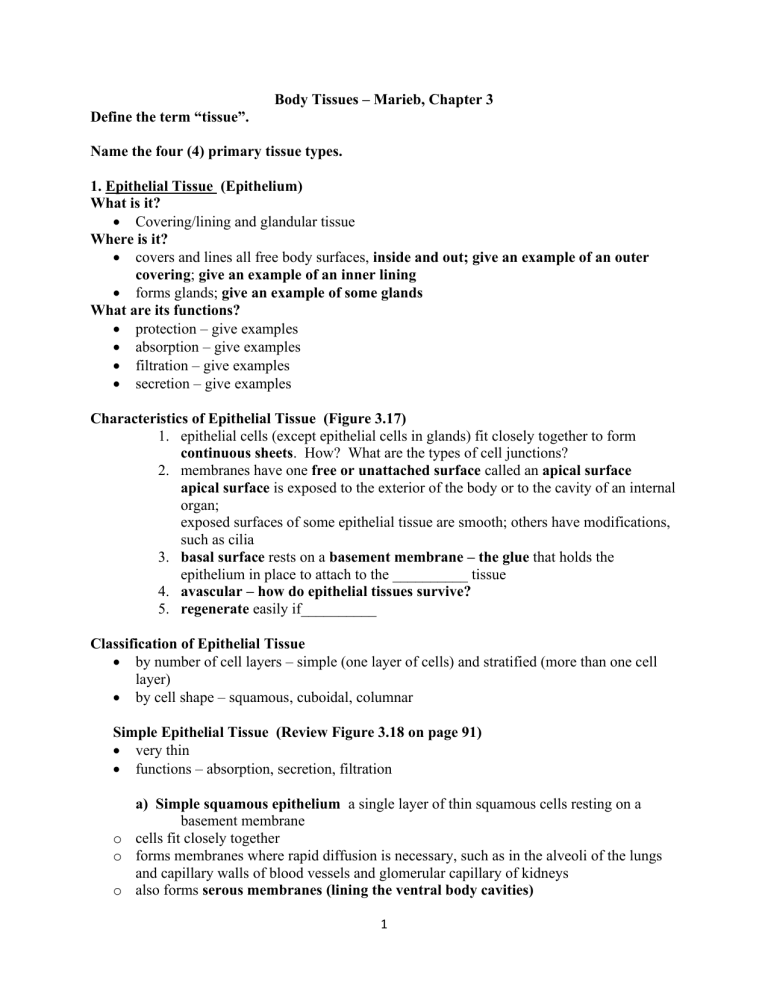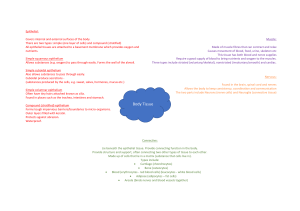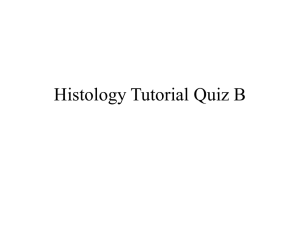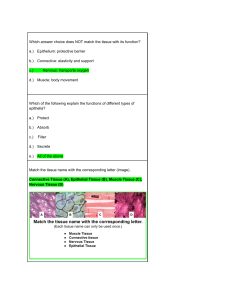
Body Tissues – Marieb, Chapter 3 Define the term “tissue”. Name the four (4) primary tissue types. 1. Epithelial Tissue (Epithelium) What is it? • Covering/lining and glandular tissue Where is it? • covers and lines all free body surfaces, inside and out; give an example of an outer covering; give an example of an inner lining • forms glands; give an example of some glands What are its functions? • protection – give examples • absorption – give examples • filtration – give examples • secretion – give examples Characteristics of Epithelial Tissue (Figure 3.17) 1. epithelial cells (except epithelial cells in glands) fit closely together to form continuous sheets. How? What are the types of cell junctions? 2. membranes have one free or unattached surface called an apical surface apical surface is exposed to the exterior of the body or to the cavity of an internal organ; exposed surfaces of some epithelial tissue are smooth; others have modifications, such as cilia 3. basal surface rests on a basement membrane – the glue that holds the epithelium in place to attach to the __________ tissue 4. avascular – how do epithelial tissues survive? 5. regenerate easily if__________ Classification of Epithelial Tissue • by number of cell layers – simple (one layer of cells) and stratified (more than one cell layer) • by cell shape – squamous, cuboidal, columnar Simple Epithelial Tissue (Review Figure 3.18 on page 91) • very thin • functions – absorption, secretion, filtration a) Simple squamous epithelium a single layer of thin squamous cells resting on a basement membrane o cells fit closely together o forms membranes where rapid diffusion is necessary, such as in the alveoli of the lungs and capillary walls of blood vessels and glomerular capillary of kidneys o also forms serous membranes (lining the ventral body cavities) 1 b) Simple cuboidal epithelium o one layer of cuboidal (cube-shaped) cells resting on a basement membrane o common in glands and their associated tubes called ducts o also form the walls of the kidney tubules c) Simple columnar epithelium o one layer of tall cells o function in secretion – goblet cells – produce mucus o lines the entire length of the digestive tract o epithelial cells that line body cavities (continuous sheet) open to the exterior of the body are called mucous membranes d) Pseudostratified Columnar Epithelium o pseudo = false o since some cells are shorter than others, this gives the false impression that there is more than one layer of cells o all cells do rest on the basement membrane o functions in absorption and secretion o pseudostratified ciliated columnar epithelium lines the respiratory tract – cells are goblet cells which produce mucus and cilia project from the cells – state the functions of mucus and cilia in the respiratory tract Stratified Epithelial Tissue • two or more cell layers, so function is primarily protection a) Stratified squamous epithelium o many cell layers o found in areas where a lot of friction occurs, such as the skin, mouth and esophagus o protects body from invading organisms and from drying out b) Stratified cuboidal epithelium c) Stratified columnar epithelium o both types (b) and (c) are rare in the human body d) Transitional epithelium o highly modified, stratified squamous epithelium – many layers o forms the lining of only a few organs of the Urinary System, such as the ureters, urinary bladder and part of urethra o cells of the basal layer are cuboidal or columnar o cells of the free surface vary o allows an organ to stretch 2 Glandular Epithelium • define the term “gland”. • glandular cells make their products and discharge them by exocytosis • two types of glands: a) endocrine glands ✓ ductless ✓ secretions (called hormones) diffuse directly into the blood vessels ✓ give examples of endocrine glands b) exocrine glands ✓ have ducts ✓ secretions exit through the ducts to the epithelial surface of skin of Integumentary System or of lining of cavity e.g., mucous lining of Respiratory System, Digestive System ✓ give examples of exocrine glands 2. Connective Tissue (Review Figure 3.19) What is it? ✓ tissue that connects body parts; living cells surrounded by extracellular matrix (interstitial space / intercellular area) Where is it? ✓ everywhere What are its functions? ✓ protecting, supporting and binding together other body tissues Characteristics of Connective Tissue a) variations in blood supply • most well vascularized • except for tendons and ligaments; cartilages are avascular b) extracellular matrix – a nonliving substance found outside the cells (interstitial area) • has two main elements: ✓ a ground substance composed mainly of water ✓ fibers which are embedded in the ground substance ➢ collagen (white) fibers which have high tensile strength ➢ elastic (yellow) fibers which can stretch and recoil ➢ reticular fibers which are fine collagen fibers that form the internal skeleton of soft organs such as the spleen 3 There are five (5) Types of Connective Tissue (with some subdivisions) a) Bone (osteocyte) (hardest) b) Cartilage (chondrocyte) i. Hyaline cartilage ii. Fibrocartilage iii. Elastic cartilage c) Dense Fibrous Connective Tissue (fibroblast) d) Loose Connective Tissue (fibroblast) i. Areolar ii. Adipose iii. Reticular e) Blood (RBC, WBC & platelets) a) Bone (osseous tissue) Figure 3.19 a) • major cell is called osteocytes which sit in cavities called lacunae • lacunae are surrounded by a very hard matrix that contains calcium salts and collagen fibers • protects and supports b) Cartilage (3 types) • major cell is a chondrocyte i) hyaline cartilage: Figure 3.19 b) ➢ the most abundant type of cartilage ➢ matrix is many collagen fibers ➢ rubbery matrix of fine collagen fibers (blue-white appearance) ➢ forms the trachea, attaches ribs to breastbone, covers ends of bones at joints ➢ note: abdominopelvic region below the ribs is called the hypochondriac region ii) fibrocartilage: Figure 3.19 c) ➢ cells are chondrocytes ➢ matrix is highly compressed collagen fibers ➢ forms the discs between the vertebrae of the spinal column and pubis symphysis iii) elastic cartilage: ➢ cells are chondrocytes ➢ matrix is many elastic fibers ➢ found in the external ear c) Dense Fibrous Connective Tissue (2 types) • composed of cells called fibroblasts that form the building blocks of the fibers • matrix is collagen i) dense regular connective tissue Figure 3.19 d) ➢ forms tendons – attach skeletal muscles to bones ➢ forms ligaments – attach bones to bones at joints ii) dense irregular connective tissue Figure 4.5 ➢ forms dermis - makes up lower layer of the skin called the dermis; note: upper skin layer called the epidermis (stratified, squamous epithelium) 4 which is attached to the dermis (dense fibrous irregular connective tissue) d) Loose Connective Tissue (3 types) i. areolar connective tissue (areola = small open space) Figure 3.19 e) ➢ the most widely distributed connective tissue variety in the body ➢ soft tissue that cushions and protects body organs ➢ universal packing tissue ➢ connective tissue glue – helps to hold internal organs together and in their proper positions ➢ fibroblast cells with fluid matrix with all types of fibers; some fibers are made of collagen; some are made of elastin proteins that are loosely scattered so most of matrix appears as empty space ➢ provides a reservoir of water and salts for surrounding tissues ➢ all body cells obtain their nutrients from and release their wastes into this “tissue fluid” ➢ pathophysiology – recall this tissue when discussing edema ii) adipose connective tissue (fat/lipid) Figure 3.19 f) ➢ an areolar tissue with mostly fat cells (the vacuole contains triglycerides lipid/fat) ➢ forms subcutaneous tissue beneath the skin ➢ protects some organs – kidneys ➢ fat “depots” – hips, breasts and belly – fat is stored and available for fuel iii) reticular connective tissue Figure 3.19 g) ➢ forms the internal framework of an organ ➢ reticular cells produce reticular fibers e) Blood (vascular tissue) Figure 3.19 h) ➢ consists of blood cells (red blood cells, white blood cells, platelets) surrounded by a fluid matrix of “fibers of blood” which are made of soluble proteins called plasma ➢ the transport vehicle for the cardiovascular system 3. Muscle Tissue (Review Figure 3.20) There are three (3) types of muscle tissue: a) skeletal muscle • attached by tendons to the skeleton • under voluntary control • contract and then pull on bones or skin, resulting in body movements, maintenance of posture, stabilization of joints or changes in facial expression • has striations; cells are long with striations due to actin and myosin • multinucleate 5 • shape - long; often called muscle fibers b) cardiac muscle • found only in the wall of the heart; function is to pump blood • under involuntary control; can be modified by the nervous system • has striations • single nucleus • shape - short, branching cells that fit tightly together at junctions called intercalated discs which contain gap (communicating) junctions and desmosome (anchoring) junctions c) smooth muscle • found in the walls of hollow organs, such as the stomach, small and large intestines, uterus, urinary bladder and blood vessels • contracts more slowly than skeletal and cardiac and contractions last longer • peristalsis is an example of smooth muscle activity • under involuntary control • no striations • single nucleus • shape - tapered at both ends Type of Muscle Tissues Fiber Appearance Location Control Skeletal Long Striated Multinucleated Attached to skeleton Voluntary Smooth Spindle-shaped Non-striated Single nucleus Wall of hollow organs (GI tract, urinary bladder, etc.) Blood vessels Duct of glands (sweat, oil, etc.) Iris of eye (controls pupil size) Ureters (connects kidneys to bladder) Arrector pili Involuntary Cardiac Branched Striated Single nucleus Intercalated disc also called gap (communicating) junctions Desmosome (anchoring) junctions Heart (myocardium) Involuntary 6 4. Nervous Tissue (Review Figure 3.21) There are two (2 ) types of nerve tissue: a) Neuron • neurons receive impulses and conduct electrochemical impulses all over the body • functional characteristics to enable them to carry out the function of impulse conduction are irritability and conductivity b) Neuroglia • supporting cells which insulate, support and protect the neurons Summary of Tissue (See Figure 3.22) Effects of Aging on Cells (See Aging Handout on eCentennial for normal aging of cells and of tissue) • epithelial membranes thin and are more easily damaged • skin loses elasticity and begins to sag • exocrine glands become less active, producing less oil, mucus and sweat • some endocrine glands produce decreasing amounts of hormones and body processes controlled by these hormones may slow down or even stop • bones become porous and weaken • tissue repair slows down • muscles begin to waste away 7






